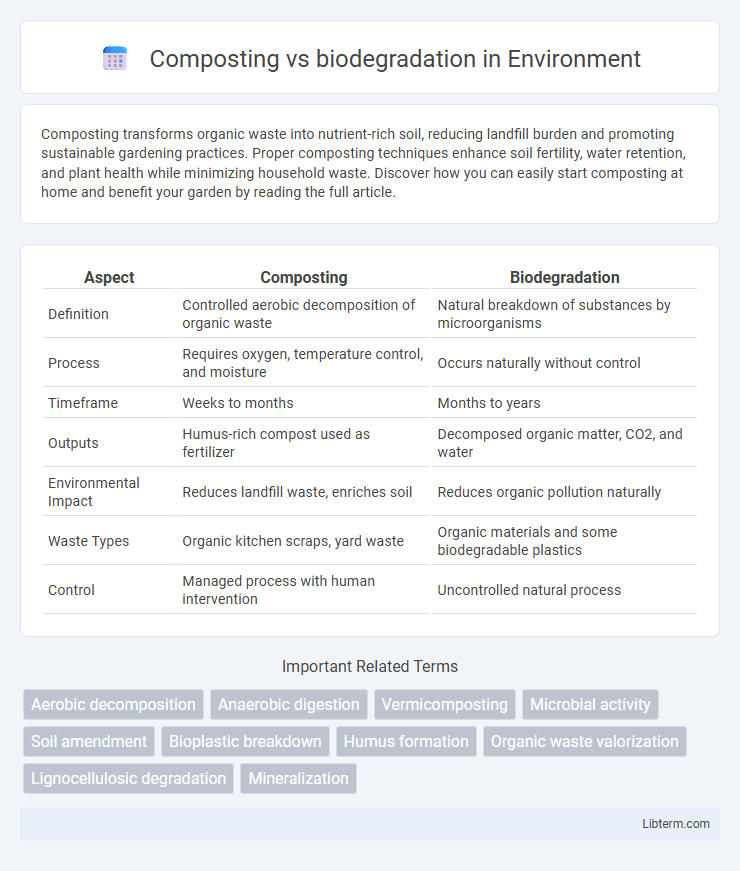Composting transforms organic waste into nutrient-rich soil, reducing landfill burden and promoting sustainable gardening practices. Proper composting techniques enhance soil fertility, water retention, and plant health while minimizing household waste. Discover how you can easily start composting at home and benefit your garden by reading the full article.
Table of Comparison
| Aspect | Composting | Biodegradation |
|---|---|---|
| Definition | Controlled aerobic decomposition of organic waste | Natural breakdown of substances by microorganisms |
| Process | Requires oxygen, temperature control, and moisture | Occurs naturally without control |
| Timeframe | Weeks to months | Months to years |
| Outputs | Humus-rich compost used as fertilizer | Decomposed organic matter, CO2, and water |
| Environmental Impact | Reduces landfill waste, enriches soil | Reduces organic pollution naturally |
| Waste Types | Organic kitchen scraps, yard waste | Organic materials and some biodegradable plastics |
| Control | Managed process with human intervention | Uncontrolled natural process |
Introduction to Composting and Biodegradation
Composting is a controlled process where organic waste, such as food scraps and yard debris, decomposes into nutrient-rich soil amendments through microbial activity in aerobic conditions. Biodegradation refers to the natural breakdown of materials by microorganisms, occurring in various environments including soil, water, and landfill sites, often under both aerobic and anaerobic conditions. Understanding the distinctions between composting's managed environment and the broader, less controlled biodegradation processes is essential for optimizing waste management and environmental sustainability.
Defining Composting: Process and Principles
Composting is a controlled biological process in which organic waste materials, such as food scraps and yard clippings, decompose under aerobic conditions to produce nutrient-rich humus called compost. This process relies on microorganisms, including bacteria and fungi, which break down complex organic compounds into simpler substances, enhancing soil fertility and structure. Key principles of composting include maintaining optimal moisture (40-60%), adequate oxygen levels through regular aeration, and a balanced carbon-to-nitrogen ratio (typically 25:1 to 30:1) to ensure efficient decomposition.
What is Biodegradation? Key Concepts
Biodegradation is the natural process whereby microorganisms like bacteria, fungi, and algae break down organic materials into simpler substances such as carbon dioxide, water, and biomass. This process occurs under various environmental conditions and involves enzymatic reactions that convert complex compounds into nutrients that can re-enter the ecosystem. Understanding biodegradation is crucial for managing waste, reducing pollution, and enhancing soil health through natural decomposition cycles.
Types of Materials Suitable for Composting vs Biodegradation
Composting effectively processes organic waste such as food scraps, yard trimmings, coffee grounds, and paper products with minimal synthetic additives, promoting nutrient-rich humus formation. Biodegradation accommodates a broader range of materials including natural fibers, biodegradable plastics, and some synthetic compounds designed to break down under environmental conditions. Selecting materials suited for composting or biodegradation ensures efficient decomposition and minimizes environmental impact by aligning with each method's microbial and chemical activity.
Environmental Impact: Composting vs Biodegradation
Composting accelerates organic matter decomposition by creating optimal conditions for microorganisms, reducing landfill waste and methane emissions significantly. Biodegradation naturally breaks down materials but often occurs slower and may release greenhouse gases if anaerobic conditions persist. Composting transforms waste into nutrient-rich soil amendments, enhancing soil health and lowering environmental pollution compared to uncontrolled biodegradation processes.
Microbial Roles in Composting and Biodegradation
Microbial roles in composting involve diverse thermophilic bacteria and fungi that accelerate organic matter decomposition by breaking down complex carbon compounds into humus, enriching soil fertility. In biodegradation, specialized microbes enzymatically degrade pollutants and plastics under environmental conditions, contributing to pollutant detoxification and material recycling. Both processes rely on microbial consortia, but composting emphasizes aerobic, high-temperature activity, whereas biodegradation can occur aerobically or anaerobically at varying temperatures.
Timeframes for Composting and Biodegradation
Composting typically completes within 2 to 6 months under optimal conditions involving controlled temperature, moisture, and aeration, accelerating organic matter decomposition. Biodegradation varies widely, ranging from weeks to several years depending on material type and environmental factors such as microbial activity, temperature, and oxygen availability. Composting offers a faster, managed process for breaking down organic waste compared to the often slower, natural biodegradation timeline in diverse ecosystems.
Practical Applications: Urban vs Rural Settings
Composting is widely implemented in both urban and rural settings to manage organic waste, with urban areas leveraging community compost bins and rooftop gardens to reduce landfill contributions. Rural settings benefit from large-scale composting systems that enhance soil fertility and support agricultural productivity by recycling crop residues and animal manure. Biodegradation naturally occurs in both contexts but is less controlled, making composting a preferred practical application for accelerating organic matter breakdown and resource recovery.
Challenges and Limitations of Each Method
Composting faces challenges such as the need for specific temperature, moisture, and aeration conditions to effectively break down organic matter, limiting its efficiency in cold or dry climates. Biodegradation, while capable of occurring in diverse environments, often suffers from slower degradation rates and incomplete breakdown due to variability in microbial communities and the presence of synthetic materials. Both methods encounter limitations in managing non-biodegradable contaminants, which can hinder overall waste reduction efforts and require careful sorting or pretreatment for optimal results.
Choosing the Right Method: Composting or Biodegradation
Composting accelerates organic waste breakdown by creating ideal conditions for microorganisms, resulting in nutrient-rich soil amendments, while biodegradation naturally decomposes materials without human intervention but at a slower pace. Choosing composting is optimal for managing kitchen scraps, garden waste, and biodegradable products when quick nutrient recycling is desired, whereas biodegradation suits products designed to break down in natural environments such as landfills or oceans. Factors like waste type, environmental impact, processing time, and desired end products guide the decision between composting and biodegradation for effective organic waste management.
Composting Infographic

 libterm.com
libterm.com